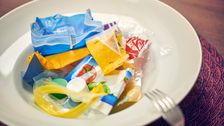
You can’t see them, but small particles of plastic are all around you ― in the air you breathe, the water you drink, even the foods you eat.
A new paper that compiles data from previous studies estimates that each year, the average American consumes over 70,000 minuscule pieces of plastic that make their way into our food through packaging, manufacturing and being swept up in the food chain. That’s more than 200 pieces a day.
Published Wednesday in the journal Environmental Science & Technology, the research looked at 26 older studies that examined the amount of microplastics in seafood, honey, salt and sugar, as well as beer and water. Researchers then estimated the amount of these foods we’re supposed to eat, based on nutrition guidelines from the United States Department of Agriculture. They wrote that about 39,000 to 52,000 microplastic particles a year come from these foods, depending on a person’s age and sex.
Those figures climbed to over 70,000 once the researchers factored in data on how much plastic we inhale as we breathe.
Drinking bottled water instead of tap water accounted for an additional 90,000 more pieces of plastic a year, the research found.
But the study noted that these numbers probably vastly underestimate the amount of plastic we unwittingly ingest day to day. The foods in the research account for only 15% of the American diet. The data did not include things like snack foods, which come packaged in plastic and ready to eat ― meaning we might be consuming far more plastics than what the research shows.
As plastics age, they shed tiny particles, called microplastics, which can linger in the environment for decades or more. These particles are smaller than a fifth of an inch in size and can be microscopic. Scientists have found microplastics in some of the planet’s most remote places, including uninhabited islands, Arctic sea ice and the deepest parts of the ocean.
Fish and other animals are known to consume microplastics, which wind their way up the food chain — right to our dinner plates.
The jury’s still out on what this all means for human health.
A study published last year analyzed the stool samples of eight people to find out whether plastic was present in their bodies. There were microplastics in the poop of all the subjects. The researchers were surprised at their findings, but acknowledged a lack of data into how this might affect health.
“The smallest particles are capable of entering the bloodstream, the lymphatic system and may even reach the liver,” Philipp Schwabl, a Medical University of Vienna researcher who co-authored that study, told HuffPost. “We need further research to understand what this may mean for human health.”
So what can people do to limit their exposure to microplastics?
At this point, contact with plastic seems pretty unavoidable. But there are steps we can take to try to reduce the amount of plastic we use once and throw away: Avoid buying items wrapped in plastic, bring a reusable water bottle or coffee mug with you on the road, and keep metal cutlery at your desk at work, for starters. They may seem like insignificant steps, but it all adds up.
“Removing single-use plastic from your life and supporting companies that are moving away from plastic packaging is going to have a non-trivial impact,” Kieran Cox, one of the authors of the new study on food and microplastics, told The Guardian.
REAL LIFE. REAL NEWS. REAL VOICES.
Help us tell more of the stories that matter from voices that too often remain unheard.
Credit: Source link